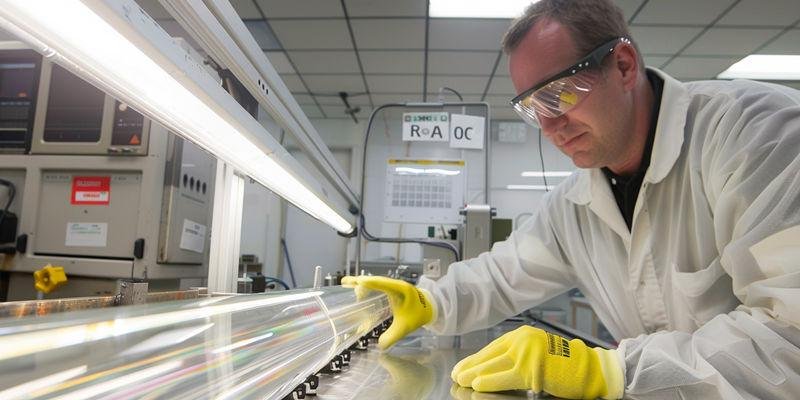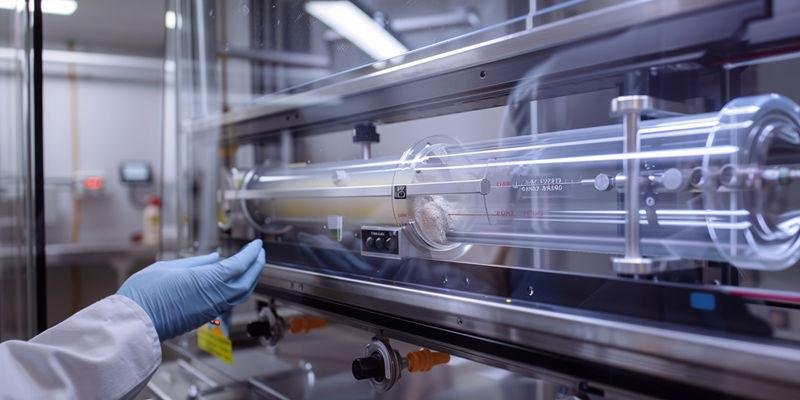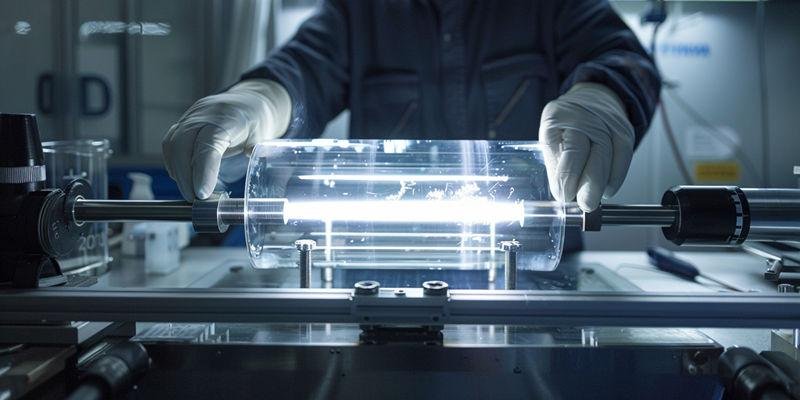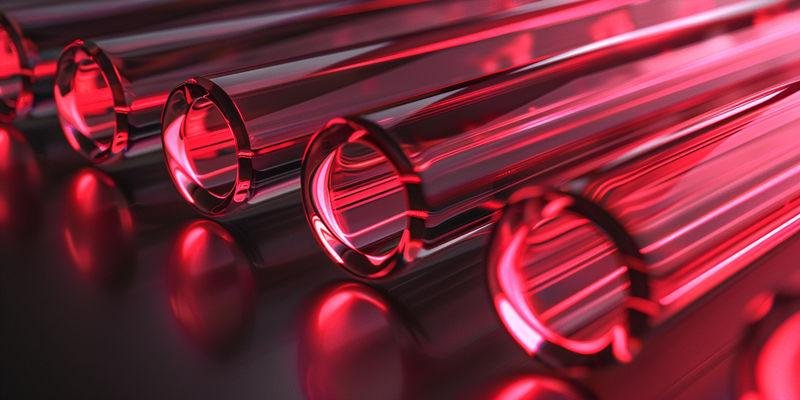
OH content in quartz tubes plays a crucial role in determining the efficiency of infrared optical transmission. Laboratory and industrial professionals rely on precise OH content quartz tubes optical infrared systems for accurate measurements and reliable performance. The table below shows how different grade types relate to OH content levels, which directly impacts infrared transparency:
Type de grade | OH Niveau de contenu |
|---|---|
Standard | < 10 ppm |
Spécialisé | < 1 ppm |
Principaux enseignements
OH content in quartz tubes directly affects infrared transmission. Lower OH levels lead to better performance.
Each 50 ppm increase in OH content can reduce transmission by about 20% at critical wavelengths. Choose tubes with less than 10 ppm for optimal results.
Manufacturing methods impact OH levels. Electric fusion with nitrogen is best for low OH content, while flame fusion often results in higher levels.
FTIR testing is essential for verifying OH content in quartz tubes. Accurate measurements prevent costly errors in sensitive applications.
Requesting quantitative OH data in material certifications ensures high-quality quartz tubes. This helps avoid performance issues in infrared systems.
What OH Content Levels Determine Infrared Transmission in Optical Quartz Tubes?

OH content quartz tubes optical infrared systems rely on precise control of material purity for optimal performance. The presence of oh groups in quartz directly affects optical transmission, especially at key infrared wavelengths. Understanding the mechanisms and manufacturing factors that influence these losses helps professionals select the right tubes for their applications.
Si-OH Vibrational Absorption Band Mechanisms
Si-OH vibrational absorption bands play a central role in limiting optical transmission in quartz tubes. The oh groups in the silica matrix absorb infrared light at specific wavelengths, including 2.72 μm, 1.39 μm, and 0.9 μm. These absorption bands result from the stretching and bending vibrations of the Si-OH bond, which create distinct peaks in the transmission spectrum.
When oh content quartz tubes optical infrared systems operate at these wavelengths, the presence of oh groups causes significant transmission loss. For example, at 2.72 μm, the fundamental stretching vibration of the Si-OH bond absorbs a large portion of the infrared light, reducing the effectiveness of the optical system. This effect becomes more pronounced as the concentration of oh groups increases, making it critical to control oh content for high-performance infrared applications.
Professionals must recognize that even small increases in oh groups can lead to measurable losses in optical transmission.
Absorption Band | Wavelength (μm) | Impact on Transmission |
|---|---|---|
Fundamental | 2.72 | Major loss |
First Overtone | 1.39 | Moderate loss |
Second Overtone | 0.9 | Noticeable loss |
Quantifying Transmission Loss per PPM OH Content
Transmission loss in oh content quartz tubes optical infrared systems increases with each additional part per million of oh groups. A tube with less than 10 ppm oh groups achieves over 85% transmission at 2.7 μm, meeting the ASTM E903 standard. Each 50 ppm increase in oh content leads to about a 20% drop in transmission at this wavelength.
This relationship means that a tube with 180 ppm oh groups, often labeled as "optical grade," may only transmit 30-50% of infrared light at 2.2 μm and 2.7 μm. Data from TOQUARTZ shows that electrically-fused quartz tubes with less than 8 ppm oh groups maintain over 88% transmission at 2.7 μm, while flame-fused tubes with 150-220 ppm oh groups drop to 35-45%. These numbers highlight the importance of verifying oh content before selecting tubes for optical infrared applications.
Selecting tubes with low oh groups ensures reliable transmission and prevents costly system failures.
Points clés :
Each 50 ppm increase in oh groups reduces transmission by about 20% at 2.7 μm.
"Optical grade" tubes with high oh content often fail in infrared applications.
ASTM E903 and TOQUARTZ data confirm the need for low-oh quartz for high transmission.
Manufacturing Process Impact on Hydroxyl Incorporation
Manufacturing methods determine the final oh content in quartz tubes, which affects their suitability for optical infrared use. Electric fusion produces quartz glass with an initial oh content of 100 to 130 ppm, but vacuum annealing can lower this level for both UV and infrared applications. Flame fusion, on the other hand, results in higher and stable oh content, typically 150-200 ppm for natural quartz and up to 1000 ppm for synthetic precursors.
Electric fusion allows for further reduction of oh groups, making it the preferred method for producing tubes with low oh content quartz tubes optical infrared systems require. Flame fusion does not permit significant reduction of oh groups, which limits its use in high-performance infrared applications. The choice of manufacturing process directly impacts the optical transmission and reliability of the final product.
Manufacturers and users must consider these differences when sourcing quartz tubes for sensitive optical infrared systems.
Méthode de fabrication | Typical OH Content (ppm) | Reduction Possible? | Infrared Suitability |
|---|---|---|---|
Fusion électrique | 100-130 | Oui | Haut |
Fusion de flammes | 150-200 (natural), up to 1000 (synthetic) | Non | Faible |
What Manufacturing Advances Minimize OH Content in Infrared-Grade Quartz Tubes?
Manufacturers use advanced techniques to reduce hydroxyl levels in high-purity silica glass for infrared applications. These methods target oh groups and silanol bonds to improve transmission and reliability. Understanding these processes helps laboratories and designers select the best quartz tubes for their needs.
Nitrogen-Atmosphere Electric Fusion Optimization
Nitrogen-atmosphere electric fusion stands out as a reliable method for producing high-purity silica glass with low hydroxyl content. The process melts natural quartz crystals in tungsten crucibles while nitrogen gas prevents water vapor from entering the melt. Data from TOQUARTZ shows that this technique consistently achieves less than 8 ppm oh groups, resulting in over 88% transmission at 2.7 μm.
Manufacturers prefer this method because it maintains low silanol levels and minimizes the risk of hydroxyl contamination. The nitrogen environment blocks atmospheric moisture, which would otherwise form additional oh groups during melting. This approach also keeps metallic impurities low, supporting both infrared and UV transparency.
Professionals often choose nitrogen-atmosphere electric fusion for critical infrared systems due to its proven effectiveness.
Key Points in Nitrogen-Atmosphere Electric Fusion:
Achieves less than 8 ppm oh groups in high-purity silica glass
Maintains low silanol and hydroxyl levels
Delivers over 88% transmission at 2.7 μm
Deuterium Substitution in Synthetic Processes
Deuterium substitution offers a powerful way to lower oh groups in synthetic high-purity silica glass. This process replaces hydroxyl with deuterium, forming OD groups instead of silanol bonds. Studies show that deuterium treatment progressively exchanges hydrogen for deuterium, which shifts absorption bands away from critical infrared wavelengths.
Infrared research reveals that the rate of hydrogen-deuterium exchange increases with temperature, making process optimization essential. Although deuterium substitution can achieve oh group levels as low as 2-5 ppm, the cost rises by three to four times compared to standard electric fusion. This method is especially valuable for applications requiring the lowest possible hydroxyl content.
Many laboratories select deuterium-substituted quartz when they need exceptional infrared performance and can justify the higher expense.
Processus | OH Groups (ppm) | Coût | Infrared Suitability |
|---|---|---|---|
Deuterium Substitution | 2-5 | Haut | Excellent |
Fusion électrique | <8 | Modéré | Très bon |
Post-Manufacture Hydrogen Annealing Techniques
Post-manufacture hydrogen annealing provides a practical solution for reducing oh groups in existing high-purity silica glass tubes. The process involves heating the tubes to 1000°C and diffusing hydrogen gas through the silica network. This reaction converts silanol bonds to Si-H, lowering hydroxyl levels by 40-60%.
TOQUARTZ data confirms that hydrogen annealing can reduce oh groups from 20 ppm to about 9-11 ppm after an eight-hour cycle. Laboratories often use this technique to recover infrared transmission in tubes that were initially specified incorrectly. The method supports cost-effective upgrades for systems that require improved performance.
Hydrogen annealing helps laboratories extend the life and utility of their high-purity silica glass components.
Summary of Hydrogen Annealing Benefits:
Reduces oh groups by up to 60%
Converts silanol to Si-H, lowering hydroxyl
Restores infrared transmission in high-purity silica glass
Why Do Flame-Fused and Electrically-Fused Quartz Tubes Have Different OH Concentrations?
Quartz tubes can have very different levels of hydroxyl content depending on how they are made. The manufacturing process determines how many oh groups end up in the final product. Understanding these differences helps laboratories and engineers choose the right material for infrared optical systems.
Oxyhydrogen Flame Chemistry and OH Formation
Flame-fused quartz tubes contain high levels of oh groups because of the chemistry involved in their production. The process uses an oxyhydrogen flame, which combines hydrogen and oxygen to create intense heat and water vapor. This water vapor reacts with molten silica, forming oh groups that become trapped in the glass.
Data from TOQUARTZ shows that flame-fused quartz typically contains 150-200 ppm oh groups, and synthetic versions can reach up to 1000 ppm. These high levels of oh groups cause significant absorption at key infrared wavelengths, making the tubes less suitable for IR applications. The presence of so many oh groups directly reduces the transmission of infrared light.
To summarize the impact of flame-fused chemistry:
Oxyhydrogen flames introduce water vapor, which forms oh groups
Flame-fused quartz often contains 150-200 ppm oh groups
High oh groups lead to poor infrared transmission
Electric Fusion with Nitrogen Atmosphere Control
Electric fusion with a nitrogen atmosphere produces quartz tubes with much lower oh groups. This method melts natural quartz crystals in a furnace using electric current, while nitrogen gas flows around the melt to keep out moisture. The absence of water vapor means fewer oh groups form during production.
TOQUARTZ manufacturing data confirms that electric fusion can achieve less than 8 ppm oh groups in the final product. These low levels allow for over 88% transmission at 2.7 μm, which meets the needs of most infrared optical systems. The nitrogen atmosphere plays a key role by preventing the formation of new oh groups.
The following table highlights the main differences:
Méthode | OH Groups (ppm) | Infrared Transmission |
|---|---|---|
Fusion de flammes | 150-200 | Faible |
Fusion électrique | <8 | Haut |
Purity Trade-offs Between Manufacturing Methods
Manufacturers must balance purity and performance when choosing a production method for quartz tubes. Flame-fused quartz often has lower metallic impurities, which makes it ideal for ultraviolet applications, but the high oh groups limit its use in the infrared range. Electric fusion may allow slightly higher metallic content, but it keeps oh groups low, supporting strong infrared transmission.
Not all synthetic quartz is suitable for infrared use. Many laboratories have installed tubes labeled as "synthetic" or "high purity" only to discover poor performance in IR systems due to unverified oh groups. Verifying oh groups before installation prevents costly errors and ensures the right material is used for each application.
Les points clés à retenir sont les suivants :
Flame-fused quartz offers low metallic impurities but high oh groups
Electric fusion provides low oh groups for better IR performance
Always verify oh groups for infrared optical systems
What Infrared Absorption Bands Does OH Content Create in Quartz Tubes?
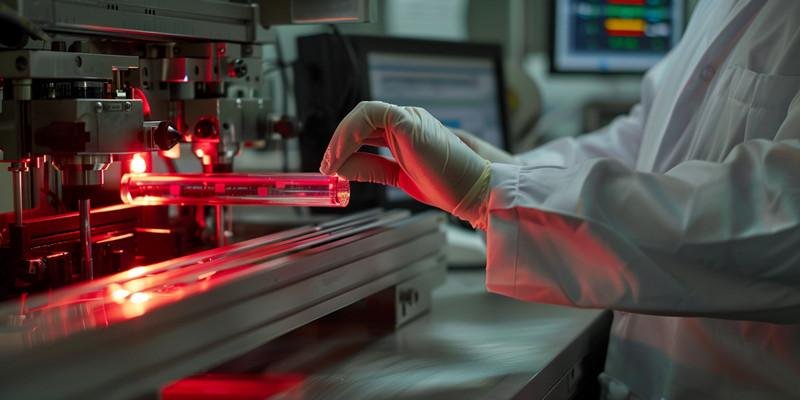
OH groups in silica play a major role in shaping the absorption spectra of quartz optical chambers. These vibrational absorption bands directly impact the optical properties and performance of silica-based systems in the near-infrared and FTIR regions. Understanding the positions, strengths, and widths of these bands helps laboratories and engineers select the right materials for their applications.
Fundamental, Overtone, and Combination Band Positions
Silica with OH groups exhibits three main vibrational absorption bands that define its infrared absorption spectra. The fundamental band appears at 2730 nm, the first overtone at 1380 nm, and the second overtone at 920 nm, each resulting from specific vibrational motions of the Si-OH bond. These bands create strong absorption features that limit the transmission of infrared light through a quartz optical chamber.
The presence of these vibrational absorption bands means that silica with higher OH content will block more infrared light at these wavelengths. For example, FTIR measurements show that the fundamental stretching vibration at 2730 nm causes major loss, while the overtone at 1380 nm leads to moderate loss in NIR applications. The second overtone at 920 nm produces noticeable but smaller absorption, affecting the overall performance of silica in optical systems.
These absorption bands form "dead zones" in the transmission window, making it essential to control OH groups in silica for high-performance optical properties.
Band | Longueur d'onde (nm) | Impact |
|---|---|---|
Fundamental | 2730 | Major loss |
First Overtone | 1380 | Moderate loss |
Second Overtone | 920 | Noticeable loss |
Beer-Lambert Absorption Coefficient Calculations
The Beer-Lambert law describes how the absorption of infrared light in silica depends on the concentration of OH groups. Each vibrational absorption band has a specific absorption coefficient, which increases as the number of OH groups rises in the quartz optical chamber. For instance, at 2730 nm, the absorption coefficient reaches 12.5 L·mol⁻¹·cm⁻¹, and transmission drops by about 18% for every 50 ppm increase in OH groups.
This relationship allows laboratories to predict how much light will be lost at each wavelength by measuring the OH content in silica. The absorption spectra become more pronounced as the OH concentration increases, creating larger "dead zones" where the optical properties of the chamber are compromised. Data from TOQUARTZ shows that tubes with less than 10 ppm OH groups maintain over 85% transmission at 2.7 μm, while those with 100 ppm drop below 50%.
In summary, the Beer-Lambert law provides a reliable way to estimate performance:
Higher OH groups lead to stronger absorption in silica.
Transmission loss scales directly with OH concentration.
Accurate calculations help prevent unexpected performance issues.
Bandwidth Impact on Spectroscopic Measurements
The bandwidth of each vibrational absorption band in silica affects how well a quartz optical chamber performs in NIR and FTIR spectroscopy. These bands do not appear as single sharp lines but instead spread over a range of wavelengths, typically ±100 nm around the central position. This broadening results from variations in hydrogen bonding and local silica structure, which can overlap with important analytical wavelengths.
Spectroscopists often encounter challenges when the absorption spectra of OH groups interfere with the detection of target compounds. For example, FTIR can identify clay minerals by their OH stretching vibrations, and temperature changes can alter absorbance in the near-infrared region, especially for samples containing water. The distinction between hydrogen-bonded and non-hydrogen-bonded OH groups also affects peak intensity, making careful control of silica composition critical for accurate measurements.
These effects highlight the need to minimize OH groups in silica to achieve reliable optical properties and consistent performance in spectroscopic applications.
Key bandwidth impacts include:
Broadened vibrational absorption bands create overlapping "dead zones"
Temperature and hydrogen bonding influence absorption spectra
Accurate silica control ensures dependable spectroscopic results
How Can Laboratories Verify OH Content Before Installing Infrared Optical Tubes?
Laboratories must confirm the OH content of quartz tubes before using them in infrared optical systems. Accurate verification prevents costly errors and ensures reliable performance in sensitive applications. This section explains FTIR testing protocols and calculation methods for determining OH concentration.
FTIR Verification Testing Protocols
FTIR spectroscopy provides a reliable way for laboratories to measure OH content in quartz tubes. The process involves passing infrared light through the tube and recording the absorption spectrum, focusing on the 2730 nm band where OH groups absorb strongly. Laboratories use this method to detect even small amounts of OH, which can impact the performance of surgery and other precision systems.
Technicians prepare the quartz sample and calibrate the FTIR instrument to ensure accurate readings. They compare the absorption at 2730 nm to baseline measurements at 2200 nm and 3000 nm, which helps isolate the effect of OH groups. This approach allows laboratories to identify tubes that meet strict requirements for surgery and other infrared applications.
A summary of the FTIR verification process appears below:
FTIR detects OH absorption at 2730 nm
Baseline readings at 2200 nm and 3000 nm improve accuracy
Results guide selection for surgery and sensitive optical systems
OH Concentration Calculation Methods
Laboratories calculate OH concentration using the Beer-Lambert law and the absorbance measured during FTIR testing. The formula OH(ppm) = 160 × (A2730 / thickness_cm) converts the absorbance at 2730 nm into a quantitative value. This calculation helps laboratories determine if a quartz tube is suitable for surgery or other infrared uses.
Technicians must measure the tube thickness accurately and use the correct absorbance values to avoid errors. Data from TOQUARTZ shows that tubes with less than 10 ppm OH content achieve over 85% transmission at 2.7 μm, which is essential for surgery and high-precision measurements. Laboratories rely on these calculations to ensure their optical systems perform as expected.
The table below summarizes the calculation steps:
Étape | Description |
|---|---|
Measure Absorbance | Record A2730 using FTIR |
Measure Thickness | Determine tube thickness in centimeters |
Apply Formula | Calculate OH(ppm) = 160 × (A2730 / thickness_cm) |
Interpret Result | Confirm suitability for surgery and IR systems |
Importance of Quantitative OH Data in Material Certifications
Requesting quantitative OH data in material certifications is critical for laboratories. Hydrous lattice point defects, known as OH defects, can significantly affect the properties and performance of quartz tubes in infrared applications. These defects influence the quality of surgery and other high-tech uses, making accurate data essential.
Material certifications that include quantitative OH data help laboratories avoid installing unsuitable tubes. The presence of OH defects can impact purity and contamination levels, which may compromise surgery outcomes or sensitive measurements. Laboratories that request detailed certifications reduce the risk of costly installation errors and system failures.
Key reasons to request quantitative OH data:
OH defects affect infrared performance and surgery reliability
Certifications with quantitative data ensure material quality
Accurate data prevents costly errors in high-tech applications
Recent research shows that higher OH content in quartz tubes leads to greater optical losses and reduced performance in infrared laser sealing and surgical systems. Low-OH quartz tubes improve reliability for surgical procedures and infrared laser sealing by minimizing silanol centres and maintaining high transmission. Laboratories should always verify OH content, as industry standards like ASTM E1479 and E903 recommend less than 10ppm for surgical and infrared laser sealing. The table below highlights the advantages of low-OH quartz tubes in surgical and infrared laser sealing:
Propriété | Low-OH Quartz Tubes | Moyenne du secteur |
|---|---|---|
Contenu de l'OH | <1ppm | 5ppm |
UV Transmittance @ 185nm | >92% | N/A |
For surgical and infrared laser sealing, always prioritize OH content specifications over generic claims to ensure optimal performance.
FAQ
What makes quartz tubes suitable for laser applications?
Quartz tubes withstand high temperatures and intense laser energy. Their low OH content ensures minimal absorption at critical wavelengths. This property allows quartz to transmit laser beams efficiently, making it ideal for laser cutting, welding, and medical laser systems.
Why does OH content affect the infrared spectra of quartz glass?
OH groups in quartz glass create strong absorption bands in the infrared spectra. The oh-stretching vibration absorbs laser energy, reducing transmission. High OH content blocks important wavelengths, which limits the effectiveness of quartz in infrared laser and spectroscopy systems.
How do laboratories verify OH content in quartz tubes before laser installation?
Technicians use FTIR spectroscopy to measure the absorption peak from the oh-stretching vibration in quartz. They calculate OH concentration using the Beer-Lambert law. This process ensures the quartz glass meets strict requirements for laser and infrared optical performance.
Why do some quartz tubes fail in high-power laser energy systems?
Quartz tubes with high OH content absorb more laser energy, causing heating and transmission loss. This absorption can damage the glass and reduce system efficiency. Low-OH quartz prevents these issues, supporting stable operation in demanding laser environments.
What are the main benefits of using low-OH quartz glass in laser optics?
Low-OH quartz glass provides high transmission, durability, and resistance to laser-induced damage. It maintains clear spectra and supports precise laser energy delivery. These qualities make low-OH quartz essential for advanced laser optics and scientific research.



